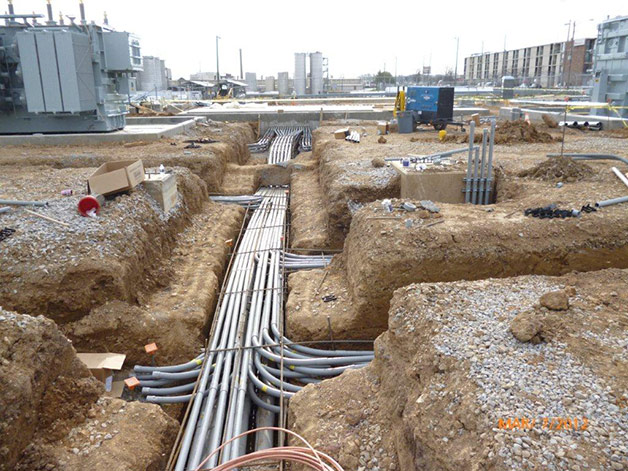UNDERGROUND NETWORKS
Undergrounding is the replacement of overhead cables providing electrical power or telecommunications, with underground cables. This is typically performed for aesthetic purposes, but also serves the additional significant purpose of making the power lines less susceptible to outages during high wind thunderstorms or heavy snow or ice storms. Undergrounding can increase the initial costs of electric power transmission and distribution but may decrease operational costs over the lifetime of the cables.
Comparison:
The aerial cables that carry high-voltage electricity and are supported by large pylons are generally considered an unattractive feature of the countryside. Underground cables can transmit power across densely populated or areas where land is costly or environmentally or asthetically sensitive. Underground and underwater crossings may be a practical alternative for crossing rivers.
Advantages:
- Less subject to damage from severe weather conditions (mainly lightning, wind and freezing)
- Reduced range of electromagnetic fields (EMF) emission, into the surrounding area. However depending on the depth of the underground cable, greater emf may be experienced. The electric current in the cable conductor produces a magnetic field, but the closer grouping of underground power cables reduces the resultant external magnetic field and further magnetic shielding may be provided.
- Underground cables need a narrower surrounding strip of about 1–10 meters to install (up to 30 m for 400 kV cables during construction), whereas an overhead line requires a surrounding strip of about 20–200 meters wide to be kept permanently clear for safety, maintenance and repair.
- Underground cables pose no hazard to low flying aircraft or to wildlife.
- Much less subject to conductor theft, illegal connections, sabotage, and damage from armed conflict.
- Burying utility lines makes room for more large trees on sidewalks, which convey environmental benefits and increase property values.
Disadvantages
- Undergrounding is more expensive, since the cost of burying cables at transmission voltages is several times greater than overhead power lines, and the life-cycle cost of an underground power cable is two to four times the cost of an overhead power line. Above ground lines cost around $10 per foot and underground lines cost in the range of $20 to $40 per foot. In highly urbanized areas the cost of underground transmission can be 10-14 times as expensive as overhead.
- Whereas finding and repairing overhead wire breaks can be accomplished in hours, underground repairs can take days or weeks, and for this reason redundant lines are run.
- Underground cable locations are not always obvious, which can lead to unwary diggers damaging cables or being electrocuted.
- Operations are more difficult since the high reactive power of underground cables produces large charging currents and so makes voltage control more difficult.
- Whereas overhead lines can easily be uprated by modifying line clearances and power poles to carry more power, underground cables cannot be uprated and must be supplemented or replaced to increase capacity. Transmission and distribution companies generally future-proof underground lines by installing the highest-rated cables while being still cost-effective.
- Underground cables are more subject to damage by ground movement. The 2011 Christchurch earthquake in New Zealand caused damage to 360 kilometres (220 mi) of high voltage underground cables and subsequently cut power to large parts of Christchurch city, whereas only a few kilometres of overhead lines were damaged, largely due to pole foundations being compromised by liquefaction.
The advantages can in some cases outweigh the disadvantages of the higher investment cost, and more expensive maintenance and management.


If you're working internationally, selecting a trusted Underground Protection Mesh Exporter ensures consistent supply and product reliability. Singhal Global caters to export markets with certified mesh products that meet global standards. To see their export offerings, Underground Protection Mesh Exporter.
ResponderEliminar